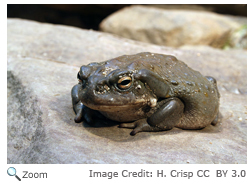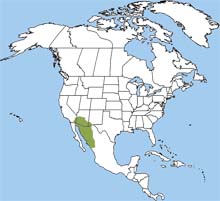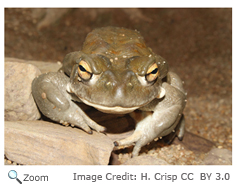Colorado River Toad - Incilius alvarius |
||||||||
Description
Range
| Habitat
DietThe Colorado River toad eats a variety of animals including spiders, insects, toads, snails, beetles, grasshoppers, mice, and small lizards. Life CycleJust before spring rains hit the desert, Colorado River toads gather at breeding pools and streams. Mating occurs from May to July. The female lays strands of black eggs. There can be as many as 8,000 eggs in a strand. The tadpoles hatch within 2-12 days. After breeding season is over, the Colorado River toad returns to its burrow, where it spends the winter. BehaviorThe Colorado River toad is nocturnal and stays underground during the heat of the day. When a Colorado River toad is threatened, it secretes a milky-white hallucinogenic toxin from the parotoid glands under its jaw. If the toxin gets in the mouth of predators, it can cause nausea and even death. |
|||||||


 The Colorado River toad is found in and around the Sonoran Desert in California and in Arizona south to Mexico.
The Colorado River toad is found in and around the Sonoran Desert in California and in Arizona south to Mexico. 